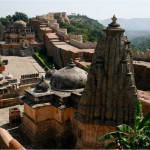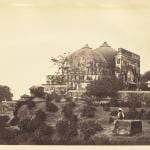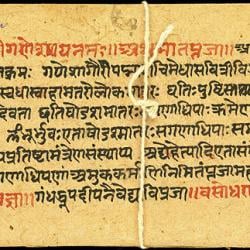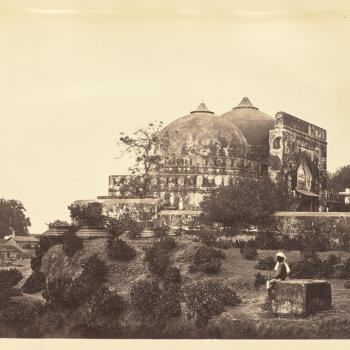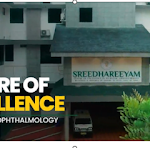The Supreme Court of India is finally moving towards a conclusion of the decades old Babri Masjid case. The final hearings will take place in the next week, and a judgement is likely by November. In this, the first of two posts, I present a “dummies” guide to this whole complex affair. If you’re too busy to read the whole post, the TL;DR right on top should help.
TL;DR: Whether the mosque was built by Babur or his armies is in doubt. None of the historical writings of Muslims or Europeans mention a mosque till about 1700. That Muslim historians would fail to mention a mosque at one of the most important sites for Hindus in north India would be very odd. There is the possibility that the mosque was built later by Aurangzeb.
It is certain that a structure existed on the mosque site earlier. A few people have tried to prove that this structure was also a mosque, but the evidence points overwhelmingly to it being a temple. Stone inscriptions of temple dedication, and sculptures have been found among the ruins of the mosque (and nearby mosques) to show that pieces of these temples were used in the construction of the mosques.
However, these archaeological findings are disputed in various ways by the Sunni Waqf board and their supporters.
The main litigants in the case are the Nirmoha Akhara, Ram Lalla (Rama the deity), and the Sunni Wakf Board. Nirmoha Akhara owns the land outside the mosque. The Sunni Waqf board is a claimant as Babur was a Sunni. Recently, the Shia Waqf Board has claimed that they are the rightful heirs to the mosque as Babur’s general Mir Baqi built the mosque and he was a Shia. The Shia Waqf board has said they have no objection to a temple being built.
Brief History of the Disputed Babri Masjid Site
Pre-Mughal Existence of Temples: This spot is said to be the exact location where Rama was born. Even till the 1800s, this spot was called Ramgarh. It is said in legends that around 1500 BC, when Rama’s descendant Brihadbala died in a great war, the place was abandoned.
19th Century British historians retell local reports of how King Vikramaditya of Ujjain built temples here in the first century BC. None of these temples existed during British times, and are said to have been demolished by either Babur or Aurangzeb.
Prior to Mughal times, three main temples would have existed in various sites in Ayodhya: one where Rama was born (Janmasthan), one where Rama cremated (Swarg Dwar), and one where Rama performed the Ashwamedh Yagna (Tretanatha or Treta ke Thakur).
In fact, till around 1989-1990, it appears to be accepted that there was a temple on the Babri Mosque site earlier. The 1986 edition of Encyclopaedia Britannica lists Babri Masjid as a mosque built by Babur on the site of an older temple.
Some people say no temple existed here: It is mainly since 1992 that questions have been raised about the existence of a temple here in popular media.
The Muslim parties claim that the idea that there was a temple here was put forth first in 1870, in a British gazette, which spoke of how there must have been a fine temple in Janmasthan, the ruins of which must have been used in the construction of babri mosque. These are close-grained, black stone called kasoti (touch stone) by locals.
The same gazette reports that in 1855, a great riot happened between Hindus and Muslims at this location, after which the British erected a fence around the mosque. The Muslims could pray in the mosque and Hindus outside the mosque. According to the gazette, “it is said that upto that time, both Hindus and Muslims worshipped in the Mosque-temple.”
Sunni Waqf board supporters also say that in the Babur Nama, Babur’s personal memoirs, no mention is made of Babur ordering the destruction of a temple or building of a mosque in Ayodhya.
This does not necessarily mean the Janmabhoomi temple was not destroyed then. It might have been destroyed by Babur’s general, Mir Baqi, not necessarily on Babur’s orders.
Later Mughal texts and texts by European travellers neither mention the existence of a mosque or a temple, but do mention that Ayodhya was a sacred place. European travelogues in the 1600-1700s mention local beliefs that the temple was destroyed by Aurangzeb or Babur.
Babri Masjid Timeline
1526: Babur invaded India in 1526 and defeated Sikander Lodhi at Panipat.
1528: The temple was probably destroyed and a mosque built in Ayodha by Mir Baqi or Baqi Tashqandi, one of Babur’s commanders.
1853: A group of armed Hindu ascetics belonging to the Nirmohi Akhara occupied the site, and claimed ownership of the structure. Periodic violence erupted in the next two years, and the civil administration had to step in, refusing permission to build a temple or to use it as a place of worship.
1855: A riot took place between Hindus and Muslims. Upto that point, it is said that Hindus and Muslims were both worshipping inside the mosque. After the riot, the British decreed that Hindus would be worshipping in the outer courtyard, and Muslims inside. The British administration fenced the site to separate the worship places because of fights that were breaking out.
1885: The head of Nirmohi Akhara filed a petition before the district judge to permit Hindus to pray to Ram Lalla inside Babri Masjid, which was not granted. Nirmohi Akhara was the holder of the title deed to the land around the mosque.
1949: Hindus are said to have placed Ram’s idols inside the Babri mosque. This led to the Muslims’ protests, with both the communities filing civil suits. The government proclaimed the site a disputed area and locked the gates.
1984- Vishwa Hindu Parishad spearheaded a committee to “liberate” the birthplace of Lord Rama and build the deity’s temple at the disputed land. Advani took charge of the campaign. In 1989, VHP laid the foundation of the temple next to the mosque.
1990- VHP volunteers damaged the mosque partially.
1991- BJP comes to power in Uttar Pradesh.
1992- Kar-sevaks, VHP, the Shiv Sena and BJP workers demolished the Babri Masjid. Communal riots in many cities followed
1994: Central govt in 1991 acquired 67 acres around the mosque. In 1994, in response to a petition against the acquisition, a Supreme Court bench held that a mosque was not an “essential part of the practice of the religion of Islam” and that namaz could be offered anywhere and hence, “its acquisition (by the state) is not prohibited by the provisions in the Constitution of India”.
2001- VHP pledged to build the Ram temple again at the disputed land on the occasion of the anniversary of Babri Masjid’s demolition.
2002- Then PM Vajpayee set up an Ayodhya cell and designated a senior official to hold talks with Hindu and Muslim leaders.
2005- Five Islamic militants attacked the Ayodhya site and tried to blow a hole in the wall of the complex with an explosive laden jeep.
2009- Liberhan commission submitted its report in the parliament blaming BJP’s active role in Babri Masjid’s demolition.
2010- Allahabad High Court decreed the division and transfer of title in three equal parts of the 2.77 acres of the disputed land to three principal claimants, one-third to Muslims, Hindus another third and the remainder to the Nirmohi Akhara sect. However, Muslims objected that Hindus got the main section of the disputed land and filed an appeal against in the court of law.
2011- The Supreme Court suspended the High Court ruling after the Hindu and Muslim groups filed an appeal against the 2010 verdict.
2017- The Supreme Court gave out its verdict, charging BJP leaders with criminal conspiracy and ordered the trial court in Lucknow to finish the hearing within two years.
February 26, 2019- The five-judge constitution bench by Chief Justice Ranjan Gogoi heard the matter February 26 and advocated an amicable resolution to the Ram Mandir case through mediation.
August 30, 2019- The UP Shia Waqf board staked a claimed over the one-third land granted to Muslim parties by the Allahabad high Court in 2010 (which was stayed by the Supreme Court). In 2017, it had said that it would give up its portion of the land and was ready to accept land at a reasonable distance or in Lucknow for a mosque.
September 24, 2019- The lawyer for the Muslim parties conceded that the belief that Ayodhya was the birthplace of Ram was correct and that there was no dispute over Ram Chabutara in the outer courtyard being the birthplace after a trial court held so. The next day he backtracked and said that what he had meant was that the Muslim parties had not challenged the court order which observed that Hindus believed this to be the birthplace of Ram.
Arguments for the hearing will end on October 18 and a verdict is expected in mid-November.
Historical Texts on Ayodhya, Babri Masjid
Skanda Purana: Provides a description of the holy city of Ayodhya and the rituals of worship in the city as well as pilgrimages to the site.
Vashista Samhita: Mentions 7 places of pilgrimage in Ayodhya and mentions Ayodhya as a place of ‘salvation’.
Travelogue of Chinese Traveller Fa Xien from 400 AD: Mentions pilgrimages to the ancient city of ‘Ayuta’ from Kanauj (in present day UP).
Travelogue of Chinese Buddhist pilgrim Hiuen Tsang from 600-670 AD: Mentions the capital of King Dasarata, known by the name of Saketa when he travelled in India.
Baburnama: No mention of a mosque but mentions city of Ayodhya. Says that Babur crossed the Sarayu river and reached Ayodhya.
Ain-i-Akbari: Mentions Lucknow as a city of recent origin and Ayodhya as one of the most sacred places of antiquity.
Travelogue of William Finch (English merchant of the East India Company) from 1608-1611: Visited Ayodhya. Mentions the worship of Lord Ram in Ayodhya. He records the “ruins of Ranichand [Ramachandra] castle and houses.” Does not mention the existence of a mosque, which is strange considering it was a massive structure.
Moghul Rajput noble Jai Singh II, in 1717, purchased land surrounding the site and his documents show a mosque.
Travelogues of Jesuit missionary Joseph Teifenthaler, 1770: Mentions several buildings on the south bank of the Sarayu river built in the memory of Lord Ram. Mentions locals who believe that the house where Ram was born was demolished by Aurangzeb or Babur. He further stated that a mosque was constructed in its place. Mentions the belief in a ‘cradle’ of Lord Ram that existed at the site. This was a mud platform worshipped by people.
Dr Buchanen, a chaplain in India noted in 1807: Dr Buchanen is the same person who wrote about Puri Jagannath, calling it Juggernaut, fabricating allegations that children were sacrificed in the “valley of idolatrous blood shed to false gods.” He called hymns in the language he did not comprehend as “obscene stanzas”, and art works on temple walls as “indecent emblems.” His audience was an evangelical audience, and his book went through numerous editions in the US.
Dr Buchanen says of temples in Ayodhya, “…if these temples ever existed, not the smallest trace of them remains; The only thing that could with probability be traced to the ancient city, are some pillars in the mosque built by Babur. These are of black stone, and of an order which I have seen nowhere else, … that they have been taken from a Hindu building, is evident, from the traces of images being observable on some of their bases; although the images have been cut off to satisfy the conscience of the bigot.”
So far, I have presented a historical backdrop to the Babri Masjid situation. In the next post, I will put across the current situation. Stay tuned!

